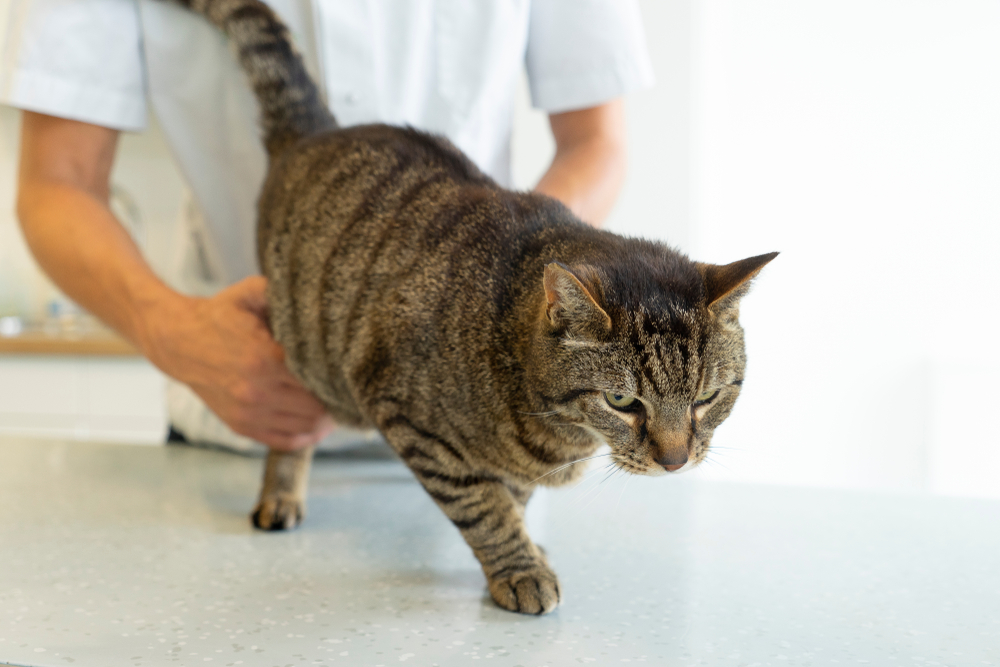Kim Campbell Thornton
September is Animal Pain Awareness Month. As pet care professionals, you know better than anyone that dogs and cats experience pain and discomfort. You also know how difficult it can be sometimes to recognize and manage chronic pain, especially in cats. Too often, pet owners assume that cats normally become less active with age, but changes in a cat’s behavior can be subtle signs of chronic pain from injury or illness.
Pain Goes Unnoticed
Chronic pain in cats is commonly underdiagnosed. Cats are so good at hiding their discomfort that it can come as a surprise to owners and even to some veterinarians to learn that they might be in pain. Owners aren’t always aware that syndromes such as glaucoma or diabetes are accompanied by pain.
Many behaviors can indicate pain in cats, including changes in functional mobility such as decreased grooming or difficulty in jumping on or off furniture; changes in sleep patterns or locations; changes in posture when sitting or sleeping; hiding; changes in litter box habits; unusual reluctance to be petted or groomed; and poor appetite. Anything that isn’t normal for a particular cat should be considered a possible sign of pain.
Causes of Chronic Pain in Cats
Many common feline diseases can cause chronic abdominal pain. Cats with this type of pain may not eat well or are nauseous and lethargic. Unless the pain is severe and constant, though, it may not be obvious when you palpate the cat.
Even once it’s identified, the level of pain can be difficult to assess. It can be a good idea to have owners keep a diary of the cat’s behaviors over a period of time or to have them complete a questionnaire.
Multimodal Relief
Managing chronic pain usually involves several types of therapy that all work together to help relieve discomfort. A combination of medication and physical therapies such as acupuncture, massage, or other rehabilitation techniques is usually most effective. Some trial and error may be necessary to find what works best.
We asked Alicia Z. Karas, DVM, DACVAA, at Cummings School of Veterinary Medicine at Tufts University, about her experience in recognizing and managing chronic pain in cats.
What should people know about pain in cats?
The first one is recognizing that the cat has pain. The cat might have arthritis, a degenerative joint condition, but nobody’s figured that out because the cat doesn’t limp. It might do things like not jump or not groom well. The other is not recognizing that a given syndrome is accompanied by pain. For many years, in dogs and cats, we thought of glaucoma as being something that threatened vision, but we know from people that glaucoma causes pain in humans and it’s a really difficult type of pain to treat. In cats and dogs, if they have an end-stage [case of glaucoma], we’ll take the eye out. Anybody who’s an ophthalmologist or who has removed an eye in an animal with glaucoma probably has heard from the owner that once that happened, the animal returns to almost a younger animal. They’ve had that chronic pain hanging over them, and once that was gone and that surgery has healed, they found their behavior much less inhibited by pain. So thinking about the fact that having skin disease or ear disease or eye disease or intestinal disease might not just be a problem for weight gain or thriving health but that it might impact pain is an important factor in terms of a barrier to pain treatment in animals.
What are some of the challenges of managing pain in cats?
When cats are resistant to being pilled, it can be a challenge. Sometimes cats need treatment for life and owners need to figure out how to get meds into the cat every day. Formulation of medication can also be a problem. One cat I treated with chronic post-trauma pain has to have one of her medications compounded because they don’t make the pills in a small enough size. They’re putting it in the food and the cat is eating it. Compounding can be very useful, but compounding medications has many drawbacks. It’s more costly, there is no guarantee that compounded medications will produce the same effects as the FDA-approved formulations, and the shelf life of compounded medications is much shorter.
What are some of the issues in treating chronic pain in cats?
A number of NSAIDs have been studied and approved for use in dogs, but that wasn’t done until fairly recently for cats. We’ve had two NSAIDs approved for use in cats for acute pain, but neither is approved for chronic use in cats in the United States, although NSAIDs are approved for long-term use in cats in Europe.
Are there other types of medications that can help cats with pain?
Gabapentin is an anti-seizure drug that was found serendipitously to have effectiveness for certain types of pain. Gabapentin can help cats with certain types of pain and is also something that can help sedate cats for car rides and vet visits. For smaller cats, though, this is a challenge because the smallest size pill that’s available is 100 mg. To reduce the amount we give requires it to be compounded or divided or made into a suspension that’s safe. People have also used tramadol in cats but it’s complicated by the fact that the taste is really bitter. We are using some things like amitriptyline, an antidepressant drug that isn’t used much for depression anymore but was found to have about five different ways that it could impact pain. It has potential use for chronic bladder pain, but some cats don’t tolerate it well. I have used other antidepressant-type drugs like Prozac in cats, at lower doses than for behavioral use, because it’s similar to amitriptyline, but maybe a little less complicated.
Can any supplements help with pain?
Cosequin is an oral joint supplement made for cats that can be useful for things like arthritis. There’s an injectable joint supplement called Adequan that is approved for use in dogs and is used off label in cats. And we’ll use things like fish oils and other supplement-type things as well.
What non-pharmacological treatments can help?
I use acupuncture in cats for chronic pain. I think that acupuncture can be very useful in cats. For acupuncture, you’d want to go once a week or once every other week at least for three to five sessions to see whether it’s going to have an effect on the cat, and then as needed, which might be monthly or every three months. It depends on the individual.
Can painful cats benefit from physical rehab?
I think people discount the benefit of physical rehab for cats, but I had one client who was pulling out all the stops for her older cat. She took him to a rehab specialist who was swimming him and doing massage and acupuncture and the cat had a really good response to that. It builds muscle, and muscle helps with joint problems. If you don’t have muscle because you haven’t been using your muscles, then you can’t support your joints, and your other muscles are really sore.
What can veterinarians suggest that owners do at home to help cats in pain?
When I see a cat for chronic pain—and I don’t see as many cats for chronic pain as I do dogs—I recommend a combination of lifestyle modifications. Those might be easier access to litterbox, ramps to furniture, and warm and cool places where they can go. Weight management is huge. If you have joint pain and you’re obese, you have way more pain than you need to because you can’t pull yourself around.
What else should be considered when managing pain in cats?
Probably the most important thing is to not be satisfied with the attitude “There’s nothing we can do.” With stomatitis, for example, taking all the teeth out is something that we commonly have done, and our dentists see at least several cats a month for this condition. If the cat isn’t a good anesthetic risk, there are medications that we don’t think of as traditionally analgesic. Certain antibiotics such as metronidazole have an anti-inflammatory effect. There are some times when joint disease affects cats and we might be able to do a surgery that helps them. We don’t do hip replacements in cats, but we can cut the hip joint and allow it to fuse and make a pseudojoint. That might help if there’s an instability. If there’s an ACL rupture or an unstable spine that’s causing back pain, surgery is the answer in combination with physical therapy and medication. I think that vets have a tendency to throw up their hands and say “It’s a cat, we can’t medicate it, there are no drugs approved for it, and it’s too much of a risk to use a medication.” Pressing on and saying ‘There is something I can do as long as I have the means or access to somebody who has different expertise’ is something that we can encourage.
This article was reviewed/edited by board-certified veterinary behaviorist Dr. Kenneth Martin and/or veterinary technician specialist in behavior Debbie Martin, LVT.
Kim Campbell Thornton is content manager for Fear Free Pets and is a Level 3 Fear Free Certified Professional. She has been writing about dogs, cats, wildlife and marine life since 1985 and is a recipient of multiple awards from the Cat Writers Association, Dog Writers Association of America, and American Society of Journalists and Authors. When she’s not writing or editing, she’s competing in nose work trials with Harper, a Cavalier King Charles Spaniel.




